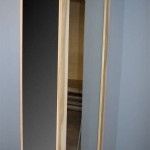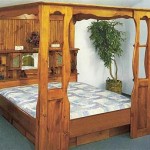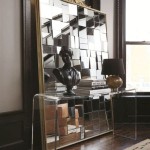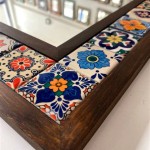Best Glue for Attaching a Wood Frame to a Mirror
Attaching a wood frame to a mirror can significantly enhance its aesthetic appeal and transform a plain mirror into a decorative focal point. However, selecting the appropriate adhesive is crucial for achieving a secure, long-lasting bond that won't damage the mirror's reflective surface or the wood frame. The optimal glue should possess characteristics such as strong adhesion to both glass and wood, resistance to moisture and temperature fluctuations, and a formulation that minimizes the risk of chemical reactions with the mirror's backing.
Several types of adhesives are commonly used for this purpose, each with its own advantages and disadvantages. Understanding the properties of these adhesives is essential for making an informed decision based on the project's specific requirements. Factors to consider include the size and weight of the frame, the type of wood used, the environment in which the mirror will be displayed, and the desired level of permanence.
Understanding Adhesive Properties for Mirror and Wood Applications
The selection of a suitable adhesive necessitates an understanding of key adhesive properties, specifically tailored to the challenges presented by bonding a wood frame to a mirror. These properties include adhesion strength, curing time, flexibility, chemical compatibility, and environmental resistance. Adhesion strength refers to the force required to separate the bonded materials. Curing time is the duration it takes for the adhesive to reach its full strength. Flexibility allows the adhesive to accommodate slight movements or expansions and contractions of the materials due to temperature or humidity changes. Chemical compatibility ensures that the adhesive does not react with or degrade the mirror's backing or the wood finish. Environmental resistance refers to the adhesive's ability to withstand exposure to moisture, heat, and ultraviolet (UV) radiation without losing its bonding strength.
Mirrors typically have a silvered or aluminized backing protected by a coating. Certain adhesives can react with these metallic layers, causing discoloration or delamination, leading to unsightly blemishes or even complete failure of the bond. Wood, being a porous and organic material, can absorb moisture, which can affect the adhesive bond strength and potentially cause warping or separation. Therefore, it is imperative to select an adhesive that mitigates these risks and provides a durable, long-lasting bond.
Furthermore, the application method also plays a critical role. The adhesive should be applied evenly and in the correct amount to ensure maximum contact area and avoid creating stress points. Clamping the frame to the mirror during the curing process can improve the bond strength and prevent movement that could weaken the adhesive as it sets.
Recommended Adhesive Types
Several types of adhesives are well-suited for bonding wood frames to mirrors. These include mirror adhesives, construction adhesives, epoxy resins, and certain types of polyurethane adhesives. Each offers unique characteristics that make them appropriate for different applications.
Mirror Adhesives: These are specifically formulated for bonding mirrors to various surfaces, including wood. They are typically neutral-cure adhesives, meaning they do not contain solvents or acids that can damage the mirror's backing. Mirror adhesives usually have a relatively slow curing time, allowing time for adjustments and proper positioning of the frame. They also tend to be more flexible than other types of adhesives, which helps to accommodate movement between the wood and the mirror due to changes in temperature or humidity. A key advantage is their designed compatibility with the delicate backing of the mirror.
Construction Adhesives: Construction adhesives are a versatile option, offering strong adhesion to a wide range of materials, including wood and glass. They are available in various formulations, some of which are specifically designed for interior applications and offer low-VOC (volatile organic compound) emissions. When using construction adhesives, it is crucial to choose a product that is labeled as safe for use with mirrors. Some construction adhesives may contain solvents that can damage the mirror's backing, so careful selection is essential. They generally provide a very strong and permanent bond, making them suitable for larger and heavier frames. However, their higher strength can sometimes lead to a less flexible bond, which may be a disadvantage in environments with significant temperature or humidity fluctuations.
Epoxy Resins: Epoxy resins are two-part adhesives that comprise a resin and a hardener. When mixed, they create a very strong, durable, and water-resistant bond. Epoxy resins provide excellent adhesion to both wood and glass and are resistant to many chemicals. However, they typically require precise mixing ratios and have a relatively short working time, which can make them more challenging to use for larger projects. Furthermore, some epoxy resins can yellow over time when exposed to UV light, which could detract from the appearance of the finished project. Careful selection of a non-yellowing epoxy is important if the mirror will be exposed to sunlight.
Polyurethane Adhesives: Polyurethane adhesives offer a strong and flexible bond and are resistant to moisture and many chemicals. They expand slightly as they cure, which helps to fill gaps and create a tight seal. However, they can also be messy to work with and may require clamping to prevent movement during the curing process. Additionally, some polyurethane adhesives may contain isocyanates, which can be harmful if inhaled or come into contact with skin. Proper ventilation and protective gear are essential when using these adhesives.
Preparation and Application Techniques
Proper preparation and application techniques are critical to achieving a strong and durable bond between the wood frame and the mirror. The first step is to thoroughly clean both the mirror's surface and the back of the wood frame. Use a mild detergent and water to remove any dirt, dust, or grease. Rinse thoroughly and allow both surfaces to dry completely before applying the adhesive. For the wood frame, consider lightly sanding the area to be bonded to create a slightly rougher surface that promotes better adhesion.
Once the surfaces are clean and dry, apply the adhesive according to the manufacturer's instructions. For mirror adhesives and construction adhesives, apply a continuous bead around the perimeter of the frame and several beads across the center. The amount of adhesive needed will depend on the size and weight of the frame. Avoid applying too much adhesive, as this can squeeze out and make a mess. For epoxy resins, mix the resin and hardener according to the manufacturer's instructions and apply a thin, even layer to both surfaces. For polyurethane adhesives, apply a bead to one surface and lightly dampen the other surface with water to promote curing.
After applying the adhesive, carefully position the frame onto the mirror and press firmly to ensure good contact. Use clamps or weights to hold the frame in place during the curing process. The curing time will vary depending on the type of adhesive used. Refer to the manufacturer's instructions for specific recommendations. Avoid moving or disturbing the assembly during the curing process, as this can weaken the bond. After the adhesive has fully cured, remove the clamps or weights and inspect the bond. If necessary, use a razor blade to carefully trim away any excess adhesive.
When working with any type of adhesive, it is important to follow the manufacturer's safety precautions. Wear gloves and eye protection to prevent skin and eye irritation. Work in a well-ventilated area to avoid inhaling harmful fumes. Dispose of unused adhesive and empty containers properly.
In summary, achieving a successful bond between a wood frame and a mirror hinges on careful selection of the adhesive, meticulous surface preparation, and precise application techniques. Understanding the properties of different adhesive types and their compatibility with mirror backings and wood is paramount. By following best practices and prioritizing safety, a durable and aesthetically pleasing result can be achieved, enhancing the beauty of the mirror for years to come.

Mirror Frame Diy How To Update A Basic Bathroom Our Faux Farmhouse

Diy Bathroom Mirror Frame For Under 10 O Hayley Blog

Diy Farmhouse Wood Frame Mirror She Gave It A Go

Mirror Frame Diy How To Update A Basic Bathroom Our Faux Farmhouse
Diy Wood Frame Mirror Farmhouse Industrial Bathroom Joyfully Treasured

Diy Stick On Mirror Frame Sawdust Sisters

Diy Stick On Mirror Frame Sawdust Sisters

Easy Driftwood Mirror The Wood Grain Cottage

Diy Farmhouse Wood Frame Mirror She Gave It A Go

Diy Bathroom Mirror Frame Without Removing Clips Her Happy Home








